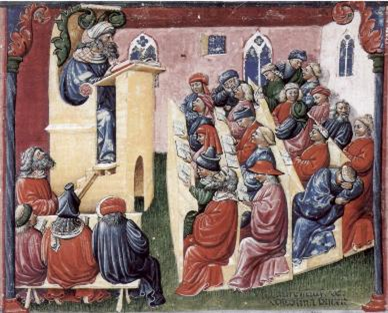16. Transmissive Lectures: Learning by Listening
16.2. The Origins of the Lecture
Transmissive lectures can be traced back as far as ancient Greek and Roman times, and certainly from at least the start of the European university, in the 13th century. The term ‘lecture’ comes from Latin, meaning a reading. In the 13th century, most books were extremely rare. They were painstakingly handcrafted and illustrated by monks, often from fragments or collections of earlier and exceedingly rare and valuable scrolls from ancient Greek or Roman times, or were translated from Arabic sources, since much documentation was destroyed in Europe during the Dark Ages following the fall of the Roman empire. As a result, a university would often have only one copy of a book, and it may have been the only copy available in the world. The library and its collection, therefore, became critical to the reputation of a university, and professors had to borrow the only text from the library and literally read from it to the students, who dutifully wrote down their own version of the lecture.
Lectures themselves belong to an even longer oral tradition of learning, where knowledge is passed on by word of mouth from one generation to the next. In such contexts, accuracy and authority (or power in controlling access to knowledge) are critical for ‘accepted’ knowledge to be successfully transmitted. Thus, accurate memory, repetition, and a reference to authoritative sources become exceedingly important in terms of validating the information transmitted. The great sagas of the ancient Greeks and, much later, of the Vikings, are examples of the power of oral transmission of knowledge, continued even today through the myths and legends of many indigenous communities.

This illustration from a thirteenth-century the manuscript shows Henry of Germany delivering a lecture to university students in Bologna, Italy, in 1233. What is striking is how similar the whole context is to lectures today, with students taking notes, some talking at the back, and one clearly asleep. Certainly, if Rip Van Winkle awoke in a modern lecture theatre after 800 years of sleeping, he would know exactly where he was and what was happening.
Nevertheless, the lecture format has been questioned for many years. Samuel Johnson (1709-1784) over 200 years ago said of lectures:
‘People have nowadays…got a strange opinion that everything should be taught by lectures. Now, I cannot see that lectures can do as much good as reading the books from which the lectures are taken…Lectures were once useful, but now, when all can read, and books are so numerous, lectures are unnecessary.’
Boswell, 1791
What is remarkable is that even after the invention of the printing press, the radio, television, and the Internet, the transmissive lecture, characterized by the authoritative instructor talking to a group of students still remains the dominant methodology for teaching in many institutions, even in a digital age, where information is available at a click of a mouse. It could be argued that anything that has lasted this long must have something going for it. On the other hand, we need to question whether the transmissive lecture is still the most appropriate means of teaching, given all the changes that have taken place in recent years, and in particular given the kinds of knowledge and skills needed in a digital age.
